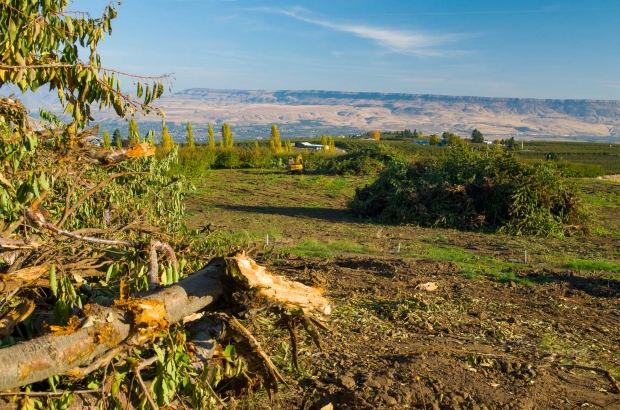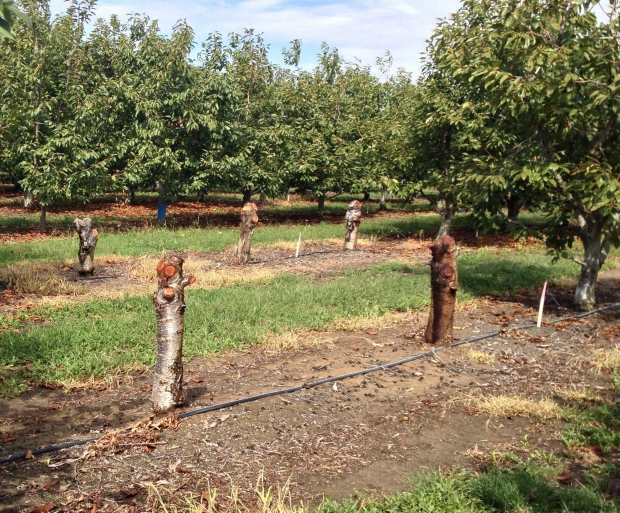With the dramatic rise of little cherry diseases in Pacific Northwest orchards and discovery of new vectors, it seems no orchard is safe from infection.
Last year, 150 acres of cherries were removed in Washington’s Chelan County because of little cherry disease. Forty acres were taken out during the previous two years.
In more southern locations in the state, the uptick in disease incidence has not been as severe, with about 800 trees removed in 2013 in Yakima County.
While both areas of the state are being affected by little cherry disease, the causal agents are completely different and require different control measures, says Dr. Ken Eastwell, plant pathologist for Washington State University and director of the Clean Plant Center Northwest in Prosser.
“The landscape has significantly changed in the last few years,” Eastwell said.
Know your enemy
So, what can you do to avoid little cherry disease?
“First, you need to know whom you’re fighting,” he said. “When you have small fruit, it means that something is interfering with the vascular system of the tree.” Small fruit can be caused from physiological conditions, like winter damage or mineral imbalance, and from pathogens, viruslike agents, and root or crown rots.
Cherries are susceptible to a wide range of pathogens. According to Eastwell, 64 viruses affect cherries, of which 44 are known in the United States.
If you see small fruit, contact your field representative to help diagnose the problem, Eastwell told growers attending the annual meeting of the Cherry Institute in Yakima, Washington. “If a virus is suspected, contact me at the WSU Clean Plant Center Northwest.”
In Washington State, three diseases are known to impact cherry quality and cause small fruit—little cherry virus 1, little cherry virus 2, and Western X phytoplasma. Little cherry 1 and 2 are both members of the Closteroviridae family, but are different genera.
“We know more about little cherry virus 2, the virus more commonly found in the Northwest and in north central Washington,” Eastwell said. Little cherry virus 2 is closely related to grapevine leafroll virus. “We don’t know a lot about little cherry virus 1.”
Little cherry virus 2
Little cherry virus 2 results in small fruit that is late to ripen, poor in color, and insipid in flavor. At yellow or straw color stage, infected fruit are similar in size to normal fruit, but by pink stage, there is significant difference in size. In some years, infected cherry trees will show foliar symptoms, but that’s not the norm, he noted.
The virus stunts tree development and shortens annual branch extensions. “Over time, little cherry virus 2 reduces the overall vigor of the tree and can be devastating,” he said.
Kootenay Valley growers in British Columbia, Canada, lost more than 30,000 trees to the disease in the 1940s and 1950s. Since 2010, the situation with little cherry virus 2 has been critical in Washington’s Chelan, Douglas, and Okanogan counties. In Grant and Yakima counties, where infections have been verified, the disease is not as severe as in north central Washington.
In addition to apple mealybug being a known vector, grape mealybug is also an effective disease carrier and transmitter, WSU researchers discovered last summer. Grape mealybug is a vector of grapevine leafroll associated disease 3, so the recent finding was not surprising.
“We suspect that any mealybug can transmit this disease,” Eastwell said.
Mealybugs are difficult to control because they overwinter in trunk crevices, inhabit the tops of trees, and have no natural enemies. As crawlers, they can travel long distances through dispersion from wind and hitchhiking on equipment and debris. “They can quickly get out of control,” he warned.
If mealybug populations are found, growers should consult pest control advisors for specific recommendations.
Little cherry virus 1
Little cherry virus 1 is in the same family as virus 2. It was the culprit in an outbreak of little cherry disease in northern Germany during the 1980s. “We know it is in British Columbia and Washington, though in relatively low incidence in the state,” Eastwell said. It spreads more slowly than virus 2 and, in Europe, it’s spread primarily by grafting.
It has milder symptoms than virus 2. However, when both little cherry viruses are combined, symptoms can be brutal. “I’ve seen mixed infections of 1 and 2 in Wenatchee, and the symptoms were very severe,” said Eastwell.
Scientists have not identified a vector for little cherry virus 1.
Western X phytoplasma
Eastwell reported that there’s been a significant increase in the last few years in Western X in Washington orchards, particularly in southern cherry-producing regions of the state. Peach trees are the primary host, although it can severely impact cherries.
During a statewide peach tree survey in the 1940s, Western X was found mostly in Asotin, Ferry, Garfield, Grant, Whitman, and Stevens counties. In Benton County, .03 percent of trees were infected near Prosser, but near White Bluffs, almost 13 percent were infected. During the peach tree survey, the disease was found to be most prevalent near virgin, sagebrush, and desert land.
Western X was first diagnosed in Washington cherry trees in 1946. A survey conducted in 1947 found nearly 1,500 infected trees out of about 170,000 inspected.
Symptoms spread slowly through the tree but quickly through an orchard. Fruit from infected trees are small, pale, and bitter tasting. “With Western X, the fruit doesn’t just taste insipid as with little cherry virus, it tastes bad,” Eastwell said.
Mahaleb rootstock appears to be hypersensitive to Western X. In California, where Mahaleb is commonly used, trees can die within nine months of infection. In Washington, infected trees usually take two years to die from the disease.
In California, where most of the transmission data comes from, cherry leafhopper and sharp-nosed leafhopper appear to pick up the disease from weeds and then transmit it from tree to tree, he reported. “We don’t have cherry and sharp-nosed leafhoppers in Washington, but we do have mountain leafhopper, the major vector here.”
Leafhoppers overwinter on winter annual weeds near water, with adults migrating to orchard weeds in late spring.
“The leafhopper doesn’t really like cherries, but, like a port in a storm, it will colonize if that’s the only plant available,” Eastwell explained.
In Washington, scientists believe that leafhoppers bring the disease into the orchard from nearby weeds. The plant host list is extensive and includes alfalfa, California burclover, clovers, curly dock, dandelion, sweet clovers, and several vetches.
“In California, it appears to spread from cherry tree to cherry tree,” said Eastwell. “But I’m not sure that is true here in Washington.”
He added that peach trees are a dead-end host, and there’s been no evidence that cherry trees are picking up disease from peach trees. •
To learn more about little cherry disease and what you can do, read: Cherry diseases require action.———–
Detection kit
A user-friendly kit to diagnose little cherry virus 2, the most common in Washington, will be available later this spring, allowing growers to quickly run a sample to detect virus using a modest laboratory (like those found in most packing houses). The technique was developed by Washington State University scientists through research funded by the Washington Tree Fruit Research Commission. The kit should be commercially available in May from Agdia, Inc. (www.agdia.com), a leading provider of test kits for plant pathogens.



I live in Virginia beach, VA is there any way I could send a picture (I’m praying this isn’t “X” disease). I haven’t been able to see any clear pictures of the disease. I have a cherry tree in my yard just one. There is something going on right where the trunk meets the ground, and up the trunk about 8 inches.